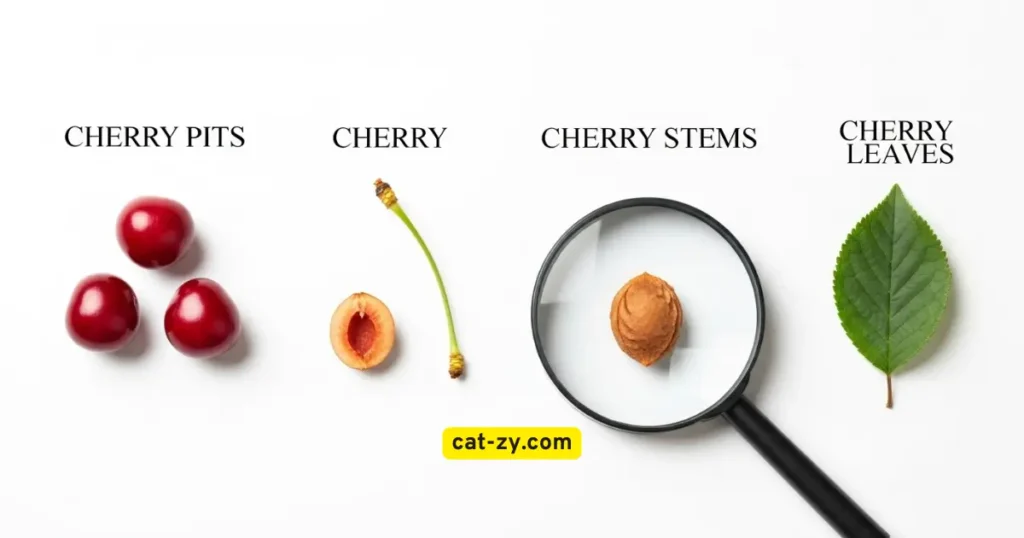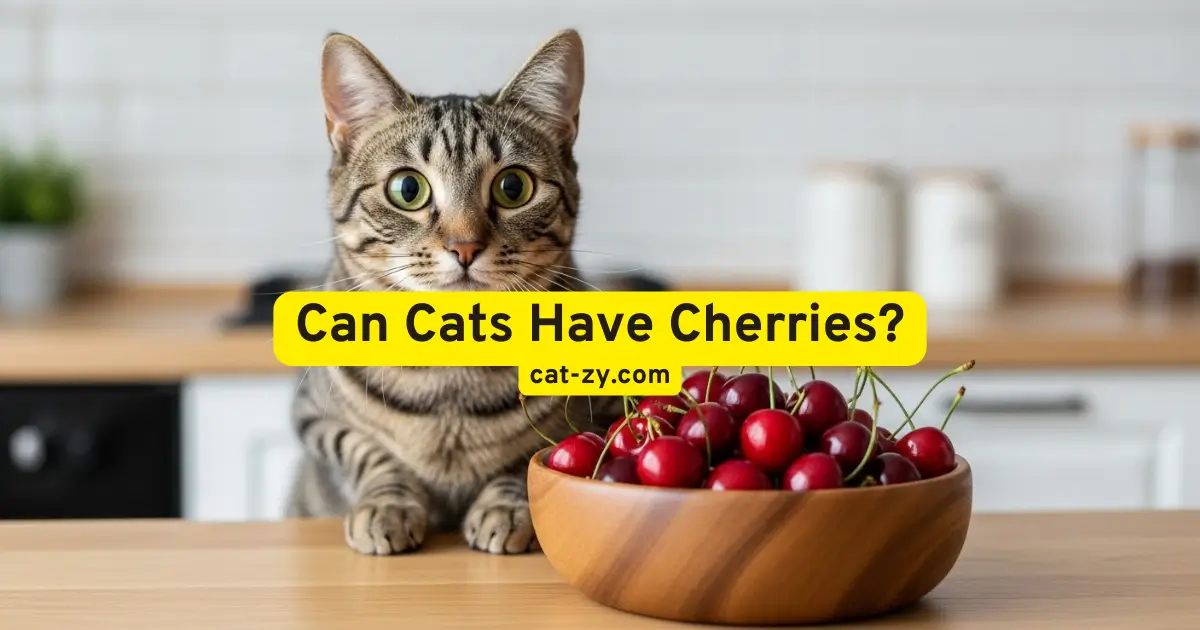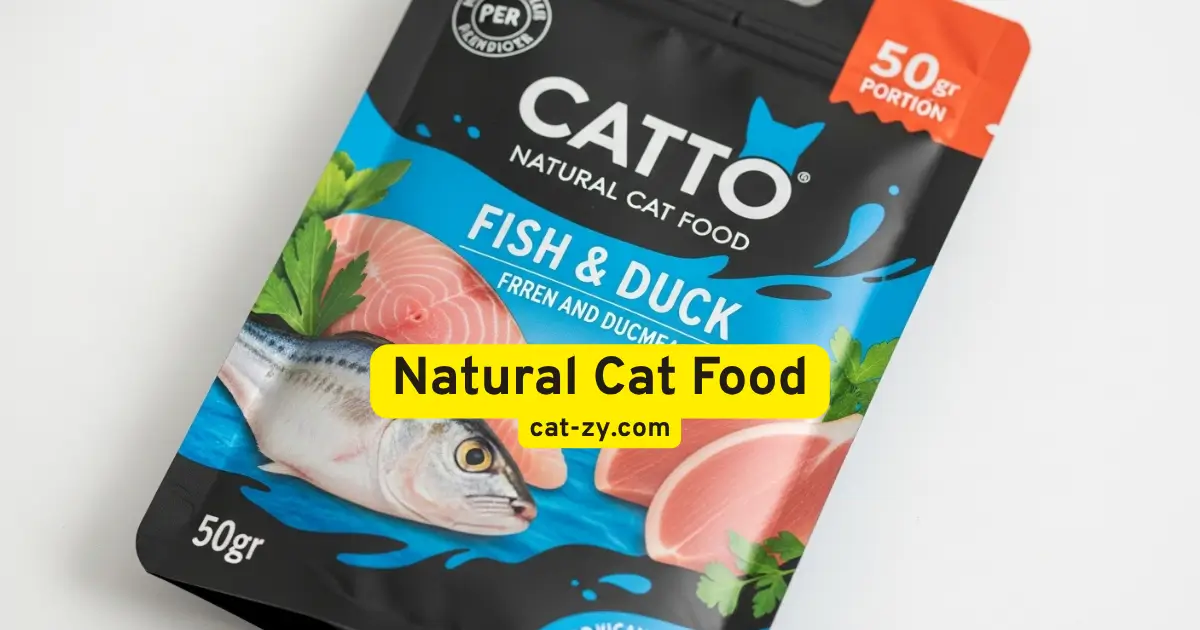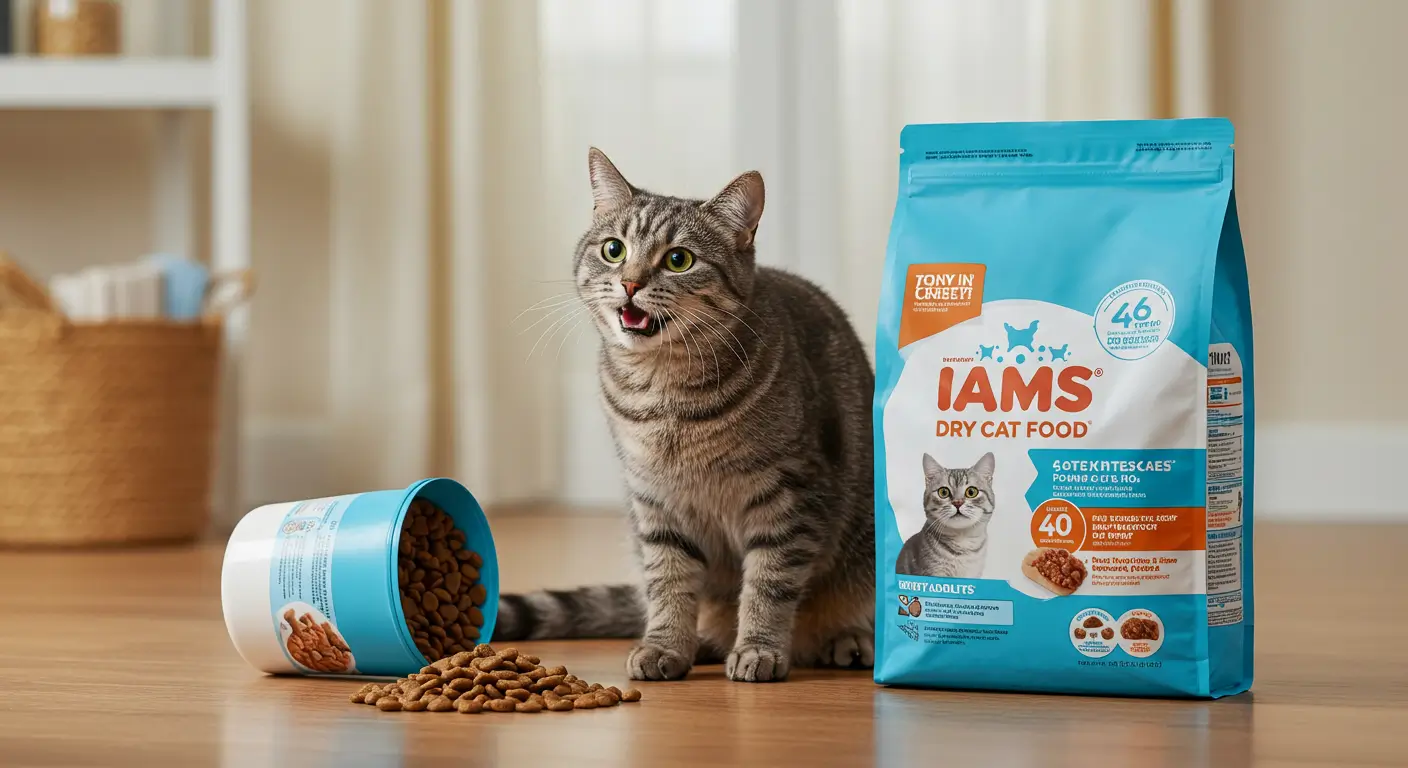Can Cats Have Cherries? 7 Shocking Reasons You Must Avoid
As a cat owner, you may wonder if sharing your favorite fruits with your feline friend is safe. Cherries are a delicious summer treat for humans, but can cats have cherries, too? The question ‘Can cats have cherries?’ is more complex than it appears. The straightforward response is negative – cherries present serious health dangers to feline pets. This comprehensive guide explains why cherries are dangerous for cats, what to do if your cat eats cherries, and which safe fruit alternatives you can offer instead.
Table of Contents
Quick Overview: Can Cats Have Cherries?
- Toxic to Cats: Yes, especially stems, leaves, and pits
- Main Danger: Cyanide poisoning
- Safe Parts: None (even the flesh contains trace amounts)
- How Often to Feed: Never
- What to Do if Consumed: Contact your veterinarian immediately
Cherries may look tempting, but they pose serious health risks to cats
Are Cherries Toxic to Cats?
Yes, cherries are considered toxic to cats. When pet owners ask ‘Can cats have cherries,’ the answer is always no due to toxicity concerns. Although ripe cherry meat holds trace toxic levels, additional components of cherry plants harbor hazardous substances that may prove fatal to your cat.
Toxic Parts of Cherries
- Cherry pits/seeds: Contain high concentrations of cyanogenic glycosides
- Stems: Toxic even in small amounts
- Leaves: Contain cyanide compounds
- Unripe fruit: Higher concentration of toxins than ripe fruit
The primary worry regarding cherries centers on their cyanide concentration. Cyanogenic glycosides in cherry pits, stems, and leaves convert to hydrogen cyanide when ingested. This toxic compound can interfere with cellular oxygen transport, potentially leading to serious health complications or even death in severe cases.
Warning: Even a single cherry pit can contain enough cyanide to harm a small cat. Never allow your cat access to any part of cherries or cherry plants.

Symptoms of Cherry Poisoning in Cats
If your cat has consumed cherries, particularly the pits, stems, or leaves, watch for these symptoms of cyanide poisoning:
Early Symptoms
- Dilated pupils
- Difficulty breathing
- Excessive drooling
- Bright red gums and tongue
- Vomiting
- Diarrhea
Advanced Symptoms
- Tremors or seizures
- Muscle spasms
- Confusion or disorientation
- Collapse
- Difficulty walking
- Shock
Watch for these warning signs if you suspect your cat has eaten cherries
Cyanide poisoning affects your cat’s ability to use oxygen at the cellular level. This is why breathing difficulties and bright red mucous membranes are common symptoms – the blood is carrying oxygen, but the cells cannot use it properly.
What to Do If Your Cat Eats Cherries
Should you believe your feline has consumed cherries, particularly seeds, stalks, or foliage, prompt intervention becomes essential:

Emergency Steps
- Do not induce vomiting unless directed by a veterinarian
- Collect any remaining cherry parts to show your vet
- Note approximately how much your cat consumed and when
- Monitor your cat for any symptoms listed above
- Contact your veterinarian or emergency animal hospital immediately
Time is critical: Cyanide poisoning can progress rapidly. Avoid delaying professional veterinary assistance until warning signs manifest when you’re certain your cat has ingested cherry seeds, stalks, or foliage.
Your veterinarian may administer treatments to counteract cyanide poisoning, including oxygen therapy, intravenous fluids, and specific medications to help the body eliminate the toxin. The earlier treatment begins, the better the prognosis for your cat.
Are Any Cherry Varieties Safe for Cats?
You might wonder if certain cherry varieties are safer than others. Unfortunately, all types of cherries pose similar risks to cats:
| Cherry Type | Safe for Cats? | Risk Level | Main Concern |
| Sweet Cherries (Bing, Rainier) | No | High | Cyanide in pits, stems |
| Tart/Sour Cherries (Montmorency) | No | High | Cyanide in pits, stems |
| Black Cherries | No | High | Cyanide in pits, stems |
| Maraschino Cherries | No | Medium | High sugar, artificial colors |
| Dried Cherries | No | Medium | High sugar, potential pit fragments |
All cherry varieties pose health risks to cats and should be avoided
Even pitted cherries or cherry products like jam, juice, or pie filling contain high sugar content and may have trace amounts of cyanide or pit fragments. These products offer no nutritional benefit to cats and can cause digestive upset, so they should also be avoided.
Safe Fruit Alternatives for Cats
If you’d like to share fruits with your cat, several safer options can be offered in small amounts as occasional treats:

Blueberries
Rich in antioxidants and low in sugar, blueberries can be a healthy occasional treat. Offer 1-2 berries, washed and cut in half.
Bananas
Offer a small piece (about the size of your fingertip) of ripe banana as an occasional treat. High in potassium but also high in sugar.
Watermelon
Seedless watermelon pieces (without rind) can provide hydration. Offer a small cube occasionally.
Remember: Fruits should only make up a tiny portion of your cat’s diet. Consistently present unfamiliar foods slowly and in limited quantities to observe for negative responses.
Though such fruits typically remain harmless in modest portions, keep in mind that felines are strict meat-eaters by nature. Their main nutrition must comprise premium feline food formulated to satisfy their particular dietary requirements. Fruits should only be occasional supplements, not dietary staples.
Not Sure What Treats Are Safe?
Consult with a veterinarian about the best treats for your specific cat’s health needs and dietary requirements.
Cherry Trees and Plants: Additional Dangers
If you have cherry trees in your yard or garden, be aware that all parts of the plant pose risks to your cat:
Every component of cherry trees and vegetation holds cyanide substances poisonous to felines.
Outdoor Safety Tips
- Consider fencing off cherry trees in your yard
- Clean up fallen cherries, leaves, and branches promptly
- Monitor outdoor cats when cherry trees are fruiting
- Consider supervised outdoor time only for cats in yards with cherry trees
Indoor Safety Tips
- Keep fresh cherries in sealed containers
- Dispose of cherry pits and stems in covered trash cans
- Clean the counters of cherry residue after preparation
- Don’t display decorative cherry branches indoors
Cherry trees aren’t the only plants containing cyanide compounds. Other fruits with similar risks include apricots, peaches, plums, and apples (seeds). Consistently investigate vegetation prior to introducing it into households containing cats.
Frequently Asked Questions
What occurs when my feline consumes a cherry seed?
If your cat eats a cherry pit, there are two main concerns: cyanide poisoning and intestinal obstruction. The pit contains cyanogenic glycosides that convert to cyanide when ingested. Symptoms of cyanide poisoning include difficulty breathing, dilated pupils, bright red gums, vomiting, and, in severe cases, collapse. Additionally, the pit itself can cause a blockage in your cat’s digestive tract. Contact your veterinarian immediately if your cat has consumed a cherry pit.
Are dried cherries safe for cats?
No, dried cherries are not safe for cats. While they typically don’t contain pits, dried cherries have concentrated sugar content that can lead to digestive upset and contribute to obesity and diabetes in cats. Some dried cherries may also contain added sugars or preservatives that are harmful to cats. Additionally, there’s always a risk of small pit fragments remaining in commercially processed dried cherries.
How many cherries are toxic to cats?
Even a single cherry can be toxic to cats if they consume the pit, stem, or leaves. The amount of cyanide in one pit could be enough to cause poisoning symptoms in a small cat. The intensity of toxic effects varies based on your feline’s body weight, consumption quantity, and specific plant components ingested. Since there’s no safe threshold established, it’s best to avoid cherries entirely and contact your veterinarian immediately if any amount is consumed.
Can cats eat the flesh of cherries if the pits are removed?
While the flesh of cherries contains less cyanide than the pits and stems, it’s still not recommended for cats. Cherry flesh offers no nutritional benefits that cats need and may cause digestive upset due to its sugar content. There’s also the risk of trace amounts of cyanide in the flesh and the possibility of pit fragments remaining. It’s safer to choose cat-specific treats or vet-approved fruits instead.

Stick to cat-specific treats rather than sharing cherries with your feline friend.
Can cats have cherries without the pit?
No, cats cannot have cherries even without the pit. While removing the pit eliminates the highest concentration of cyanide, cherry flesh still contains trace amounts of toxic compounds. Additionally, cherry flesh offers no nutritional value to cats and can cause digestive upset due to its high sugar content, making it an unnecessary risk.
Can cats have cherry seeds?
Absolutely not. Cherry seeds (pits) are extremely dangerous for cats as they contain high concentrations of cyanogenic glycosides that convert to deadly hydrogen cyanide when digested. Even a single cherry seed can contain enough cyanide to poison a small cat, potentially causing breathing difficulties, seizures, and even death in severe cases.
Can cats have cherries if they don’t eat the pit?
No, cats should not have cherries regardless of whether they consume the pit. Even if your cat only licks or nibbles the cherry flesh, they’re still exposed to trace cyanide compounds. The stems and leaves also contain dangerous toxins, and there’s always a risk of accidental pit ingestion or pit fragments remaining on the fruit.
Why do people ask ‘Can cats have cherries’ so frequently?
Pet owners commonly ask, “Can cats have cherries?” because they want to share healthy human foods with their feline companions. Cherries appear harmless and nutritious to humans, leading to natural curiosity about their safety for cats. However, what’s healthy for humans can be toxic to cats due to their different digestive systems and metabolic processes.
Conclusion: Keeping Your Cat Safe
When it comes to the question ‘can cats have cherries,’ the answer is clear – it’s best to avoid them completely. The risks of cyanide poisoning from cherry pits, stems, and leaves far outweigh any potential benefits. Even the flesh of cherries offers little nutritional value to cats while posing unnecessary risks.
Instead, focus on providing your cat with a balanced diet of high-quality cat food supplemented with vet-approved treats. If you want to offer fruits occasionally, stick to safer options like small amounts of blueberries, bananas, or seedless watermelon.

Remember that cats are obligate carnivores with specific dietary needs different from humans. What’s healthy for us isn’t necessarily healthy for them. When in doubt about any food’s safety for your cat, always consult with your veterinarian first.








One Comment
Comments are closed.